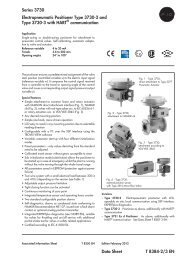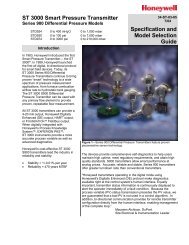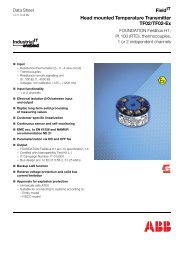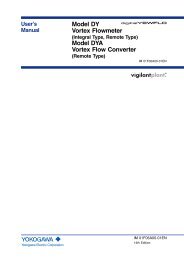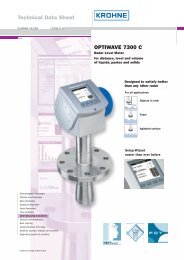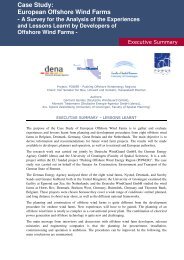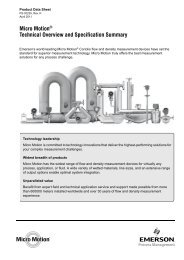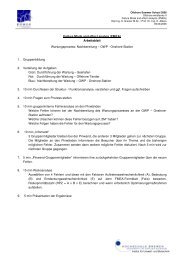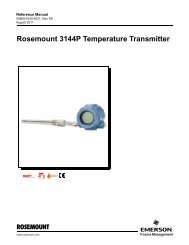IF302 - English Manual - Smar
IF302 - English Manual - Smar
IF302 - English Manual - Smar
- No tags were found...
Create successful ePaper yourself
Turn your PDF publications into a flip-book with our unique Google optimized e-Paper software.
<strong>IF302</strong> – Operation and Maintenance Instruction <strong>Manual</strong>WARNINGThis <strong>Manual</strong> is compatible with version 3.XX, where 3 denote software version and XX softwarerelease. The indication 3.XX means that this manual is compatible with any release of softwareversion 3.Waiver of responsibilityThe contents of this manual abides by the hardware and software used on the current equipmentversion. Eventually there may occur divergencies between this manual and the equipment. Theinformation from this document are periodically reviewed and the necessary or identified correctionswill be included in the following editions. Suggestions for their improvement are welcome.WarningFor more objectivity and clarity, this manual does not contain all the detailed information on theproduct and, in addition, it does not cover every possible mounting, operation or maintenancecases.Before installing and utilizing the equipment, check if the model of the acquired equipment complieswith the technical requirements for the application. This checking is the user’s responsibility.If the user needs more information, or on the event of specific problems not specified or treated inthis manual, the information should be sought from <strong>Smar</strong>. Furthermore, the user recognizes that thecontents of this manual by no means modify past or present agreements, confirmation or judicialrelationship, in whole or in part.All of <strong>Smar</strong>’s obligation result from the purchasing agreement signed between the parties, whichincludes the complete and sole valid warranty term. Contractual clauses related to the warranty arenot limited nor extended by virtue of the technical information contained in this manual.Only qualified personnel are allowed to participate in the activities of mounting, electrical connection,startup and maintenance of the equipment. Qualified personnel are understood to be the personsfamiliar with the mounting, electrical connection, startup and operation of the equipment or othersimilar apparatus that are technically fit for their work. <strong>Smar</strong> provides specific training to instruct andqualify such professionals. However, each country must comply with the local safety procedures,legal provisions and regulations for the mounting and operation of electrical installations, as well aswith the laws and regulations on classified areas, such as intrinsic safety, explosion proof, increasedsafety and instrumented safety systems, among others.The user is responsible for the incorrect or inadequate handling of equipments run with pneumaticor hydraulic pressure or, still, subject to corrosive, aggressive or combustible products, since theirutilization may cause severe bodily harm and/or material damages.The field equipment referred to in this manual, when acquired for classified or hazardous areas, hasits certification void when having its parts replaced or interchanged without functional and approvaltests by <strong>Smar</strong> or any of <strong>Smar</strong> authorized dealers, which are the competent companies for certifyingthat the equipment in its entirety meets the applicable standards and regulations. The same is truewhen converting the equipment of a communication protocol to another. In this case, it is necessarysending the equipment to <strong>Smar</strong> or any of its authorized dealer. Moreover, the certificates aredifferent and the user is responsible for their correct use.Always respect the instructions provided in the <strong>Manual</strong>. <strong>Smar</strong> is not responsible for any lossesand/or damages resulting from the inadequate use of its equipments. It is the user’s responsibility toknow and apply the safety practices in his country.IV
Table of ContentsTABLE OF CONTENTSSECTION 1 - INSTALLATION ...................................................................................................................... 1.1GENERAL ................................................................................................................................................................................. 1.1MOUNTING............................................................................................................................................................................... 1.1ELECTRIC WIRING .................................................................................................................................................................. 1.1TOPOLOGY AND NETWORK CONFIGURATION ................................................................................................................... 1.3INPUT WIRING ......................................................................................................................................................................... 1.4SECTION 2 - OPERATION ........................................................................................................................... 2.1FUNCTIONAL DESCRIPTION – ELECTRONICS..................................................................................................................... 2.1SECTION 3 - CONFIGURATION .................................................................................................................. 3.1TRANSDUCER BLOCK ............................................................................................................................................................ 3.1HOW TO CONFIGURE A TRANSDUCER BLOCK................................................................................................................... 3.1TERMINAL NUMBER................................................................................................................................................................ 3.1PRIMARY VALUE STATUS ...................................................................................................................................................... 3.2CURRENT TRIM....................................................................................................................................................................... 3.2VIA LOCAL ADJUSTMENT....................................................................................................................................................... 3.5DISPLAY TRANSDUCER BLOCK ............................................................................................................................................ 3.5DEFINITION OF PARAMETERS AND VALUES....................................................................................................................... 3.6PROGRAMMING USING LOCAL ADJUSTMENT .................................................................................................................... 3.9J1 JUMPER CONNECTIONS ................................................................................................................................................. 3.10W1 JUMPER CONNECTIONS................................................................................................................................................ 3.10SECTION 4 - MAINTENANCE...................................................................................................................... 4.1GENERAL ................................................................................................................................................................................. 4.1TROUBLESHOOTING .............................................................................................................................................................. 4.1DISASSEMBLY PROCEDURE ................................................................................................................................................. 4.2REASSEMBLE PROCEDURE .................................................................................................................................................. 4.2BOARDS INTERCHANGEABILITY........................................................................................................................................... 4.2EXPLODED VIEW..................................................................................................................................................................... 4.3ACCESSORIES ........................................................................................................................................................................ 4.3SPARE PARTS LIST................................................................................................................................................................. 4.4SECTION 5 - TECHNICAL CHARACTERISTICS ........................................................................................ 5.1FUNCTIONAL SPECIFICATIONS............................................................................................................................................. 5.1PERFORMANCE SPECIFICATIONS........................................................................................................................................ 5.1PHYSICAL SPECIFICATIONS.................................................................................................................................................. 5.2ORDERING CODE.................................................................................................................................................................... 5.2RETURNING MATERIALS........................................................................................................................................................ 5.2APPENDIX A – SRF – SERVICE REQUEST FORM................................................................................... A.1APPENDIX B - SMAR WARRANTY CERTIFICATE ................................................................................... B.1V
<strong>IF302</strong> – Operation and Maintenance Instruction <strong>Manual</strong>VI
Installation FlowchartInstallation FlowchartStartWas the converterconfigured on the benchto match the application?YesInstall the converter on the fieldfollowing the instructions below.NoConfigure the engineering unit.Install the converterpreferablyon wether-protected areas.Configure the terminal(s)and input scale(s) .(Section 3 - Calibration)Configure the LCD reading.(Section 3 - Configuration)Check the area classificationand its practices.Install the converter(mechanicallyand electrically) according to theapplication after checking the bestposition for the LCD(Section 4 - Maintenance).Simulate the value(s) in the 4 a20 mA input and verify thesignal(s) in Fieldbus.Is the indication correct?NoSee section 4 - MaintenanceYesEnergize the converter properly.<strong>IF302</strong> needs a external power supplyfor supply the 4 - 20 mA equipment .OKVII
<strong>IF302</strong> – Operation and Maintenance Instruction <strong>Manual</strong>VIII
Section 1GeneralINSTALLATIONThe overall accuracy of measurement and control depends on several variables. Although theconverter has an outstanding performance, proper installation is essential, in order to maximize itsperformance.Among all factors, which may affect converter accuracy, environmental conditions are the mostdifficult to control. There are, however, ways of reducing the effects of temperature, humidity andvibration.Locating the converter in areas protected from extreme environmental changes can improve theconverter performance.In warm environments, the converter should be installed to avoid as much as possible, directexposure to the sun. Installation close to lines and vessels subjected to high temperatures shouldalso be avoided.Use of sunshades or heat shields to protect the converter from external heat sources should beconsidered, if necessary.MountingHumidity is fatal to electronic circuits. In areas subjected to high relative humidity, the O-rings for theelectronics cover must be correctly placed. Removal of the electronics cover in the field should bereduced to the minimum necessary, since each time it is removed the circuits are exposed to thehumidity. The electronic circuit is protected by a humidity proof coating, but frequent exposures tohumidity may affect the protection provided. It is also important to keep the covers tightened inplace. Every time they are removed, the threads are exposed to corrosion, since painting cannotprotect these parts. Code-approved sealing methods on conduit entering the converter should beemployed.Using the bracket, the mounting may be done in several positions, as shown on Figure 1.3 -Dimensional Drawing and Mounting Positions.Electric WiringFor better visibility, the digital indicator may be rotated in steps of 90° (See Section 4 - MaintenanceProcedures).Access the wiring block by removing the Electrical Connection Cover. This cover can be lockedclosed by the cover locking screw (See Figure 1.1 - Cover Locking). To release the cover, rotate thelocking screw clockwise.Cable access to wiring connections is obtained by one of the two conduit outlets. Conduit threadsshould be sealed by means of code-approved sealing methods. The unused outlet connectionshould be plugged accordingly.COVERLOCKINGSCREWFigure 1.1 - Cover Locking1.1
<strong>IF302</strong> - Operation and Maintenance Instruction <strong>Manual</strong>For convenience there are three ground terminals: one inside the cover and two externals, locatedclose to the conduit entries.The wiring block has screws, on which fork or ring type terminals can be fastened, see Figure 1.2 -Terminal Block.POWERSUPPLYTERMINALSGROUNDTERMINALCOMUNICATIONTERMINALSFigure 1.2 - Terminal BlockThe <strong>IF302</strong> uses the 31.25 kbit/s voltage mode option for the physical signaling. All other devices onthe same bus must use the same signaling. 12 to 16 devices can be connected in parallel along thesame pair of wires.Various types of Fieldbus devices may be connected on the same bus.The <strong>IF302</strong> is powered via the bus. The limit for such devices is 16 for one bus (one segment) fornon-intrinsically safe requirement.In hazardous area, the number of devices may be limited by intrinsically safe restrictions.The <strong>IF302</strong> is protected against reverse polarity, and can withstand ±35 VDC without damage.NOTEPlease refer to the General Installation, Operation and Maintenance <strong>Manual</strong> for more details.Figure 1.3 - Dimensional Drawing and Mounting Positions1.2
InstallationTopology and Network ConfigurationWARNINGHAZARDOUS AREASIn hazardous areas with explosion proof requirements, the covers must be tightened with at least 8 turns. Inorder to avoid the penetration moisture or corrosive gases, tighten the O’ring until feeling the O'ring touchingthe housing. Then, tighten more 1/3 turn (120°) to guarantee the sealing. Lock the covers using the lockingscrew.In hazardous zones with intrinsically safe or non-incendive requirements, the circuit entity parameters andapplicable installation procedures must be observed.Cable access to wiring connections is obtained by the two conduit outlets. Conduit threads should be sealedby means of code-approved sealing methods.Explosion proof, non-incendive and intrinsic safety Factory Mutual certification are standards for <strong>IF302</strong>.Should other certifications be necessary, refer to the certification or specific standard for installationlimitations.Bus topology (See Figure 1.4 - Bus Topology) and tree topology (See Figure 1.5 - Tree TopologyConfiguration) are supported. Both types have a trunk cable with two terminations. The devices areconnected to the trunk via spurs. The spurs may be integrated in the device giving zero spur length.A spur may connect more than one device, depending on the length. Active couplers may be usedto extend spur length.Active repeaters may be used to extend the trunk length.The total cable length, including spurs, between any two devices in the Fieldbus should not exceed1900m.The connection of couplers should be kept less than 15 per 250m.IN24VDC1A2AOUT 1Fieldbus H13A4APSI302 3.0 (Power Supply Impedance)OUT 2Fieldbus H1OUT 3Fieldbus H1OUT 4Fieldbus H1BT5A6A7A8A9A10ATerminatorEnabledSpur+FUSE2,5APS302smarPSI302JunctionBoxShieldONFAILONFAIL 1TerminatorFAIL 2FAIL 3FAIL 4Spur+ Spur +smarsmarFigure 1.4 - Bus Topology1.3
<strong>IF302</strong> - Operation and Maintenance Instruction <strong>Manual</strong>TerminatorEnabledJunctionBoxPS302ONPSI302ONFAILFAIL 1FAIL 2CouplerFAIL 3FAIL 4smarsmarFigure 1.5 - Tree Topology ConfigurationInput WiringFIELDBUS+_The <strong>IF302</strong> accepts up to three current inputs in the range 0-20 mA or 4-20 mA. The three inputshave a common ground and they are protected from reverse polarity signal. The inputs should beconnected as per Figure 1.6 - Input Wiring.<strong>IF302</strong>1234 a 20mATRANSMITTER 1TRANSMITTER 2TRANSMITTER 3++++_POWERSUPPLY4Figure 1.6 - Input WiringNote that <strong>IF302</strong> can operate with 0-20 mA or 4-20mA transmitters (See Figure 1.7 - Connection).1.4
Installation+TR-1CHANNEL11CHANNEL1+PowerSupply-++4-20mATR-TR-2CHANNEL 23 CHANNEL 330-20mA +- +0-20mA4- 4COMMON0-20mA-+4-wire 0-20mA Transmitters or0-20mA Current Generator2CHANNEL 2CHANNEL 3COMMONTR = TransmitterCONNECTIONFigure 1.7 - ConnectionAvoid routing input wiring close to power cables or switching equipment.WARNINGApply in the inputs of the conversor only current levels. Don't apply tension levels, because the shuntresistors are of 100R 1W and tension above 10 Vdc it can damage them.1.5
<strong>IF302</strong> - Operation and Maintenance Instruction <strong>Manual</strong>1.6
Section 2OPERATIONFunctional Description – ElectronicsThe <strong>IF302</strong> accepts signals from mA generators such as most conventional transmitters. It istherefore ideal for interfacing existing equipment to a Fieldbus system.Refer to the block diagram (See Figure 2.1 - <strong>IF302</strong> Block Diagram). The function of each block isdescribed below.MUX MultiplexerThe MUX multiplexes the input terminals to ensure that all three channels reach the A/D converter.A/D ConverterThe A/D converts the input signals to a digital format for the CPU.Signal IsolatorIts function is to isolate the data signal between the input and the CPU.(CPU) Central Processing Unit, RAM and FLASHThe CPU is the intelligent portion of the converter, being responsible for the management andoperation of block execution, self-diagnostics and communication. The program is stored in Flashmemory. For temporary storage of data there is a RAM. The data in the RAM is lost if the power isswitched off, however the device also has a nonvolatile EEPROM where data that must be retainedare stored. Examples of such data are: calibration, configuration and identification data.Communication ControllerIt monitors line activity, modulates and demodulates the signal from network line.Power SupplyTakes power of the loop-line to power the converter circuitry.Power IsolationJust like the signals from the input section, the power to the input section must be isolated.Display ControllerReceives data from the CPU and drives the Liquid Crystal Display.Local AdjustmentThey are two switches that are magnetically activated. They can be activated by the magnetic toolwithout mechanical or electrical contact.2.1
<strong>IF302</strong> – Operation and Maintenance Instruction <strong>Manual</strong>MAIN CIRCUIT BOARDINPUT CIRCUIT BOARDPOWERISOLATIONPOWERSUPPLYSIGNALSHAPINGSUPPLYFIRMWAREDOWLOADINTERFACEFLASHRAMMODEMDISPLAY BOARDLOCAL ADJUSTCPUEEPROMSIGNALISOLATIONA/DMUX(*) Resistor Shunt3 x 1001234DISPLAYCONTROLLERFigure 2.1 - <strong>IF302</strong> Block Diagram* WARNINGApply in the inputs of the conversor only current levels. Don't apply tension levels, because the shuntresistors are of 100R 1W and tension above 10 Vdc it can damage them.2.2
Section 3CONFIGURATIONOne of the many advantages of Fieldbus is that device configuration is independent of theconfigurator. The <strong>IF302</strong> may be configured by a third party terminal or operator console.The <strong>IF302</strong> contains three input transducer blocks, one resource block, one display transducer blockand function blocks.Function Blocks are not covered in this manual. For explanation and details of function blocks, seethe “Function Blocks <strong>Manual</strong>”.Transducer BlockHow to Configure a Transducer BlockTerminal NumberTransducer block insulates function block from the specific I/O hardware, such as sensors andactuators. Transducer block controls access to I/O through manufacturer specific implementation.This permits the transducer block to execute as frequently as necessary to obtain good data fromsensors without burdening the function blocks that use the data. It also insulates the function blocksfrom the manufacturer specific characteristics of certain hardware.By accessing the hardware, the transducer block can get data from I/O or passing control data to it.The connection between Transducer block and Input/Output Function blocks is called channel.Normally, transducer blocks perform functions, such as linearization, characterization, temperaturecompensation, control and exchange data to/from hardware.The transducer block has an algorithm, a set of contained parameters and a channel connecting it toa function block.The algorithm describes the behavior of the transducer as a data transfer function between the I/Ohardware and other function block. The set of contained parameters, it means, you are not able tolink them to other blocks, defines the user interface to the transducer block. They can be divided intoStandard and Manufacturer Specific.The standard parameters will be present for such class of device, as pressure, temperature,actuator, etc., whatever is the manufacturer. Oppositely, the manufacturers specific ones aredefined only by its manufacturer. As common manufacturer specific parameters, we have calibrationsettings, material information, linearization curve, etc.When you perform a standard routine as a calibration, you are conducted step by step by a method.The method is generally defined as guide line to help the user to make common tasks. TheSYSCON configurator identifies each method associated to the parameters and enables theinterface to it.The terminal number, which references a physical input, which is sent internally from the specifiedtransducer output to function block.It starts at one (1) for transducer number one until three (3) for transducer number three.The channel number of the AI block is related to the transducer’s terminal number. Channel number1, 2, 3 corresponds bi-univocally to the terminal block with the same number. Therefore, all the userhas to do is to select combinations: (1.1), (2.2), (3,3) for (CHANNEL, BLOCK).3.1
<strong>IF302</strong> - Operation and Maintenance Instruction <strong>Manual</strong>Primary Value StatusThe status of the Primary Value can follow the NAMUR NE 43 as showed bellow:3.80 mA < input < 20.5 mA → GOODinput = 3.80 mA or input = 20.5 → UNCERTAINinput = 21.0 mA → BADTo disable this feature, just write a number different from 4 or 20 in the Transducer xd_scaleparameter.Current TrimThe <strong>IF302</strong> provides the capability of making a trim in the input channels, if necessary.A trim is necessary if the indicator reading of the transducer block output differs from the actualphysical output. The reason may be:• The user's current meter differs from the factory standard.• The converter had its original characterization shifted by over-load or by long term drift.The user can check the calibration of the transducer output by measuring the actual current in theinput and compare it with the device’s indication (of course an appropriate meter shall be used). If amismatch is detected, a trim can be done.Trim can be done in two points:Lower Trim: Is used to trim the output at the lower range.Upper Trim: Is used to trim the output at the upper range.These two points define the linear characteristic of the output. Trim in one point is independent fromthe other.There are at least two ways of doing the trim: using local adjustment or using SYSCON (the SystemConfigurator from SMAR).When doing the trim, make sure you are using an appropriate meter (with the necessary accuracy).Via SYSCONThe channel number of the AI block is related to the transducer’s terminal block number. Channelnumber 1,2,3 corresponds bi-univocally to the terminal block with the same number. Therefore, allthe user has to do is to select combinations: (1,1), (2,2), (3,3), for (CHANNEL, TERMINALNUMBER).3.2
ConfigurationThis parameterselects theterminal numberwhich the inputcurrent will begenerated andcalibrated.In this case thechannel 1 waschosen.Figure 3.1 - Current Trim - <strong>IF302</strong>It is possible to calibrate the current inputs of the transmitter by means of parametersCAL_POINT_LO and CAL_POINT_HI.Let’s take the lower value as an example:Supply 4 mA or the lower value to the terminal block and wait until the readout of parameterPRIMARY_VALUE stabilizes.Write 4.00 or the lower value in parameter CAL_POINT_LO. For each value written a calibration isperformed at the desired point.This parameterindicates where theconverter should bewhen the setpointlower value is 0%.The desiredvalue should beentered.Let’s take the upper value as an example:Figure 3.2 - Current Trim - <strong>IF302</strong>Supply 20 mA or the upper value to the terminal block and wait until the readout of parameterPRIMARY_VALUE stabilizes.Write 20.00 or the upper value in parameter CAL_POINT_HI. For each value written a calibration isperformed at the desired point.3.3
<strong>IF302</strong> - Operation and Maintenance Instruction <strong>Manual</strong>This parameterindicates where theconverter should bewhen the setpoint is100%.The desired valueshould be entered.Figure 3.3 - Current Trim - <strong>IF302</strong>WARNINGIt is recommendable that a convenient engineering unit be chosen by means of parameter XD_SCALE of theAnalog Input Block, considering that the range limits of the sensor must be respected, these being 100% and0%.It is also recommendable, for every new calibration, to save existing trim data in parametersCAL_POINT_LO_BACKUP and CAL_POINT_HI_BACKUP, by means of parameter BACKUP_RESTORE,using option LAST_TRIM_BACKUP.3.4
ConfigurationVia Local AdjustmentThe <strong>IF302</strong> has 3 input transducers and its device leaves SMAR with factory settings. The factorysetting establishes only the transducers #1 as default for local adjustment. In order to configure theothers via local adjustment, the user should configure them in the display transducer via SYSCON,according specific instructions for this transducer block.In order to enter the local adjustment mode, place the magnetic tool in orifice “Z” until flag “MD”lights up in the display. Remove the magnetic tool from “Z” and place it in orifice “S” until themessage “LOC ADJ” is displayed. The message will be displayed during approximately 5 secondsafter the user removes the magnetic tool from “S”. By placing the magnetic tool the user will be ableto access the local adjustment tree in the monitoring mode.Browse to parameter P_VAL (PRIMARY_VALUE).Supply 4.0mA or the lower value to the terminal block and wait until the read of the parameterstabilizes in the display.Browse to parameter “LOWER”. After that, in order to start calibration, the user will act on theparameter “LOWER” by placing the magnetic tool in “S” down to 4.0 mA.Let’s take the upper value:Supply 20.0mA or the upper value to the terminal block and wait until the readout of parameterP_VAL stabilizes, and then actuate parameter UPPER up to 20.0.Trim mode exits via local adjustment automatically when the magnetic tool is not used duringapproximately 16 seconds.NOTEKeep in mind that even when parameters LOWER or UPPER present the desired value, they must be actuatedso that calibration is performed.Limit Conditions for Calibration:For every writing operation in the transducer blocks there is a code indication for the operationassociated with the writing method. These codes appear in parameter XD_ERROR every time acalibration is performed. Code 16, for example, indicates a successfully performed operation.Lower:0.0mA < NEW_ LOWER < 9.0mAOtherwise, XD_ERROR = 22Upper:15.0 mA < NEW_UPPER < 22.0mAOtherwise, XD_ERROR = 22.Codes for XD_ERROR:… 16: Default Value Set… 22: Out of range… 26: Invalid Calibration request… 27: Excessive CorrectionNOTEDisplay Transducer BlockThe local adjustment tree is completely configured by SYSCON. It means, the user can select thebest options to fit his application. From factory, it is configured with the options to set the Upper andLower trim, for monitoring the input transducer output and check the Tag. Normally, the transmitteris much better configured by SYSCON, but the local functionality of the LCD permits an easy andfast action on certain parameters, since it does not rely on communication and network wiringconnections. Among the possibilities by Local Adjustment, the following options can be emphasized:Mode block, Outputs monitoring, Tag visualization and Tuning Parameters setting.3.5
<strong>IF302</strong> - Operation and Maintenance Instruction <strong>Manual</strong>Definition of Parameters and ValuesThe interface between the user is described very detailed on the "General Installation, Operationand Maintenance Procedures <strong>Manual</strong>". Please take a detailed look at this manual in the chapterrelated to "Programming Using Local Adjustment". It shows significantly the resources on thistransducer display. All Series 302 field devices from SMAR have the same methodology to handlewith it. So, since the user has learned once, he is capable to handle all kind of field devices fromSMAR.All function blocks and transducers defined according Foundation Fieldbus have a description oftheir features written on binary files, by the Device Description Language. This feature permits thatthird parties configurator enabled by Device Description Service technology can interpret thesefeatures and make them accessible to configure. The Function Blocks and Transducers of Series302 have been defined rigorously according the Foundation Fieldbus specifications in order to beinteroperable to other parties.In order to enable the local adjustment using the magnetic tool, it is necessary to previously preparethe parameters related with this operation via SYSCON (System Configurator). The Figure 3.8 -Parameters for Local Adjustment Configuration and the Figure 3.11 - Step 1 - <strong>IF302</strong> show allparameters and their respective values, which shall be configured in accordance with the necessityof being locally adjusted by means of the magnetic tool. All values shown on the display are defaultvalues.There are seven groups of parameters, which may be pre-configured by the user in order to allow apossible configuration by means of the local adjustment. As an example, let’s suppose that youdon’t want to show some parameters; in this case, simply write an invalid Tag in the parameter,Block_Tag_Param_X. Doing this, the device will not take the parameter related (indexed) to the Tagas a valid parameter.Block_Tag_ParamThis is tag of the block to which the parameter belongs. Use up to a maximum of 32 characters.Index_RelativeThis is the index related to the parameter to be actuated or viewed (0, 1, 2…). Refer to the FunctionBlocks <strong>Manual</strong> to know the desired indexes, or visualize them on the SYSCON by opening thedesired block.Sub_IndexIn case you wish to visualize a certain tag, opt for the index relative equal to zero, and for the subindexequal to one (refer to paragraph Structure Block in the Function Blocks <strong>Manual</strong>).MnemonicThis is the mnemonic for the parameter identification (it accepts a maximum of 16 characters in thealphanumeric field of the display). Choose the mnemonic, preferably with no more than 5 charactersbecause, this way, it will not be necessary to rotate it on the display.Inc_DecIt is the increment and decrement in decimal units when the parameter is Float or Float Status time,or integer, when the parameter is in whole units.Decimal_Point_NumberThis is the number of digits after the decimal point (0 to 3 decimal digits).AccessThe access allows the user to read, in the case of the “Monitoring” option, and to write when "action"option is selected, then the display will show the increment and decrement arrows.Alpha_NumThese parameters include two options: value and mnemonic. If option value is selected, the displaywill show data both in the alphanumeric and in the numeric fields; this way, in the case of a datahigher than 10000, it will be shown in the alphanumeric field.If option mnemonic, the display will show the data in the numeric field and the mnemonic in thealphanumeric field.3.6
ConfigurationIn case you wish to visualize a certain tag, opt for the index relative equal to zero, and for the subindexequal to one (refer to paragraph Structure Block in the Function Blocks <strong>Manual</strong>).Figure 3.4 - Parameters for Local Adjustment ConfigurationFigure 3.5 - Parameters for Local Adjustment Configuration3.7
<strong>IF302</strong> - Operation and Maintenance Instruction <strong>Manual</strong>Figure 3.6 - Parameters for Local Adjustment ConfigurationFigure 3.7 - Parameters for Local Adjustment Configuration3.8
ConfigurationThis parameterupdates the localadjustmentprogramming treeconfigured on eachdevice.The option "update" shouldbe selected in order toexecute the upgrade of localadjustment programmingtree.After its step all theparameters selected will beshow on the LCD display.Programming Using Local AdjustmentFigure 3.8 - Parameters for Local Adjustment ConfigurationThe converter has two holes for magnetic switches activated by the magnetic tool located under theidentification plate (See Figure 3.9). These magnetic switches are activated by one magnetic tool.This magnetic tool enables adjustment of the most important parameters of the blocks. It alsoenables pre-configuration of the communication.The jumper J1 on top of the main circuit board must be in place for this function to be enabled andthe transmitter must be fitted with the digital display for access to the local adjustment. Without thedisplay the local adjustment is not possible.Magnetic ToolSpan HoleZero HoleFig. 3.9 - Local Adjustment HolesTable 3.1 shows the actions on the Z and S holes on the LD302 when Local Adjustment is enabled.HOLEZSACTIONInitializes and rotates through the available functions.Selects the function shown in the display.Table 3.1 - Purpose of the holes on the Housing3.9
<strong>IF302</strong> - Operation and Maintenance Instruction <strong>Manual</strong>J1 Jumper ConnectionsW1 Jumper ConnectionsIf J1 (see figure 3.10) is connected to ON, it is possible to simulate values and status through theSIMULATE parameter, from the function blocks.If W1(see figure 3.10) is connected to ON, the local adjustment programming tree is enabled, theblock parameters can be adjusted and the communication can be pre-configured via localadjustment.WROFFJ1ONOFFW1ONLOCADJMAIN BOARDFig. 3.10 - J1 and W1 JumpersIn order tostart the localadjustment,place themagnetic toolin orifice Zand wait untilletters MDaredisplayed.5.00 5.00Place themagnetictool in orificeS and waitduring 5seconds.Figure 3.11 - Step 1 - <strong>IF302</strong>3.10
ConfigurationRemovethemagnetictool fromorifice S.Insert themagnetictool in orificeS once moreand LOCADJ shouldbedisplayed.5.00Figure 3.12 - Step 2 - <strong>IF302</strong>In this option (P_VAL)is showed with itsrespective value(if you to want that itkeeps static, put thetool in S orifice andstay there.5.00P_VAL3.8LOWERThis parameter isused to calibrate thelower current point. Inorder to range thelower value, simplyinsert the magnetictool in orifice S assoon as lower isshown on the display.An arrow pointingupward ( ) incrementthe value and anarrow pointingdownward (↓)decrement the value.Figure 3.13 - Step 3 - <strong>IF302</strong>In order todecrementthe lowervalue, placethe magnetictool in orificeZ to shift thearrow to thedownwardposition andthen, byinserting andkeeping thetool in orificeS, it isThis parameter is usedto calibrate the uppercurrent point. In orderto range the uppervalue, simply insert themagnetic tool in orificeS as soon as upper isshown on the display.An arrow pointingupward ( ) incrementthe value and an arrowpointing downward (↓)decrement the value.Apply the 20.0 mAcurrent in the 1 and 4Figure 3.14 - Step 4 - <strong>IF302</strong>3.11
<strong>IF302</strong> - Operation and Maintenance Instruction <strong>Manual</strong>a) In order todecrement theaddress value,place themagnetic tool inorifice Z to shiftthe arrow to thedownwardposition and then,by inserting andkeeping the tool inorifice S, it ispossible toFigure 3.15 - Step 5 - IF303NOTEThis Local adjustment configuration is a suggestion only. The user may choose his preferred configurationvia SYSCON, simply configuring the display block (refer to paragraph Display Transducer Block ).3.12
Section 4GeneralMAINTENANCESMAR <strong>IF302</strong> Current to Fieldbus Converters are extensively tested and inspected before delivery tothe end user. Nevertheless, during their design and development, consideration was given to thepossibility of repairs by the end user, if necessary.In general, it is recommended that the end user do not try to repair printed circuit boards. Instead,he should have spare circuit boards, which may be ordered from SMAR whenever necessary.TroubleshootingSymptom: No Quiescent CurrentProbable Sources of Trouble:Converter Fieldbus ConnectionsCheck wiring polarity and continuity.Power SupplyCheck power supply output. The voltage at the <strong>IF302</strong> Fieldbus terminals must be between 9 and 32VDC.Electronic Circuit FailureCheck the boards for defect by replacing them with spare ones.Symptom: No CommunicationProbable Source of TroubleNetwork ConnectionsCheck the network connections: devices, power supply, and terminators.Network ImpedanceCheck the network impedance (power supply impedance and terminators).Transmitter ConfigurationCheck configuration of communication parameters of converter.Network ConfigurationCheck communication configuration of the network.Electronic Circuit FailureTry to replace the converter circuit with spare parts.Symptom: Incorrect InputsProbable Source of Trouble:Input Terminals ConnectionCheck wiring polarity and continuity.Conventional TransmitterVerify if the conventional transmitter is working properly or if it has the necessary voltage.Remember that <strong>IF302</strong> has a 100 ohms plus 0.8 V input impedance.CalibrationCheck calibration of <strong>IF302</strong> and the conventional transmitters.4.1
<strong>IF302</strong> - Operation and Maintenance Instruction <strong>Manual</strong>If the problem is not presented in the table above follow the Note below:NOTEThe Factory Init should be tried as a last option to recover the equipment control when the equipmentpresents some problem related to the function blocks or the communication. This operation must only becarried out by authorized technical personnel and with the process offline, since the equipment willbe configured with standard and factory data.This procedure resets all the configurations run on the equipment, after which a partial download should beperformed.Two magnetic tools should be used to this efect,. On the equipment, withdraw the nut that fixes theidentification tag on the top of the housing, so that access is gained to the "S" and "Z" holes.The operations to follow are:1) Switch off the equipment, insert the magnetic tools and keep them in the holes (the magnetic end in theholes);2) Feed the equipment;3) As soon as Factory Init is shown on the display, take off the tools and wait for the "5" symbol on the rightupper corner of the display to unlit, thus indicating the end of the operation.This procedure makes effective all the factory configuration and will eliminate eventual problems with thefunction blocks or with the equipment communication.Disassembly ProcedureRefer to Figure 4.1 - <strong>IF302</strong> Exploded View Make sure to disconnect power supply beforedisassembling the converter.To remove the circuit boards (5 and 7) and display (4), first loose the cover locking (8) on the sidenot marked “Field Terminals”, then unscrew the cover (1).WARNINGThe boards have CMOS components, which may be damaged by electrostatic discharges. Observe correctprocedures for handling CMOS components. It is also recommended to store the circuit boards inelectrostatic-proof cases.Loose the two screws (3) that anchors the display and the main circuit board. Gently pull out thedisplay, and then the main board (5). To remove the input board (7), first unscrew the two screws (6)that anchors it to the housing (9), and gently pull out the board.Reassemble ProcedureBoards Interchangeability• Put input board (7) into housing (9).• Anchors input board with their screws (6).• Put main board (5) into the housing, ensuring all inter connecting pins are connected.• Put display (4) into the housing, observing the four mounting positions. "_" should point in thedirection desired as UP.• Anchors main board and display with their screws (3).• Fit the cover (1) and lock it using the locking screw (8).Main and input boards are supposed to stay together, because calibration data from input boardcircuit is stored in EEPROM of the main board.4.2
MaintenanceWARNINGIf, for some reason, you separate the input and the main boards, you must do a trim to guarantee precision ofthe inputs. With mismatched boards, the factory trim will not be so good as it was.Exploded View91011121234567813161415Figure 4.1 - <strong>IF302</strong> Exploded ViewAccessoriesACCESSORIESORDERING CODESD1BC302SYSCONPS302PSI302BT302PCIDESCRIPTIONMagnetic Tool for Local AdjustmentFieldbus/RS232 InterfaceSystem ConfiguratorPower SupplyPower Supply ImpedanceTerminatorProcess Control Interface4.3
<strong>IF302</strong> - Operation and Maintenance Instruction <strong>Manual</strong>Spare Parts ListSPARE PARTS LISTDESCRIPTION OF PARTS POSITION CODECATEGORY(NOTE 4)Cover Without Window (Includes O-Ring)Aluminium 1 and 15 204-0102316 Stainless Steel 1 and 15 204-0105Cover With Window for Indication (Includes O-Ring)Aluminium 1 204-0103316 Stainless Steel 1 204-0106O-Rings (Note 2) Cover, Buna-N 2 204-0122 BAluminium Housing Main Board ScrewUnits With Indicator 3 304-0118Units Without Indicator 3 304-0117316 Stainless Steel Housing Main Board ScrewUnits With Indicator 3 204-0118Units Without Indicator 3 204-0117Digital Indicator 4 214-0108Main and Input Circuit Board Assembly 5 and 7 334-0150 AInput Board ScrewAluminium Housing 6 314-0125316 Stainless Steel Housing 6 214-0125Cover Locking Screw 8 204-0120½ - 14 NPT 9 324-0150Housing, Aluminium (Note 1)M20 x 1.5 9 324-0151PG 13.5 DIN 9 324-0152½ - 14 NPT 9 324-0153Housing, 316 Stainless Steel (Note 1)M20 x 1.5 9 324-0154PG 13.5 DIN 9 324-0155Local Adjustment Protection Cap 10 204-0114Identification Plate Fixing Screw 11 204-0116Terminal Insulator 12 314-0123External Ground Screw 13 204-0124Terminal Holding ScrewHousing in Aluminium 14 304-0119Housing in 316 Stainless Steel 14 204-0119Six-Sided Plug 1/2" NPT Internal BR ExBichromated Carbon Steel 16 400-0808Bichromated 304 Stainless Steel 16 400-0809Six-Sided Plug 1/2" NPT InternalBichromated Carbon Steel 16 400-0583-11Bichromated 304 Stainless Steel 16 400-0583-12Six-Sided Plug M20 X 1.5 External BR Ex d 316 Stainless Steel 16 400-0810Six-Sided Plug PG13.5 External BR Ex d 316 Stainless Steel 16 400-0811Carbon Steel - 214-0801316 Stainless Steel - 214-0802Mounting Bracket for 2” Pipe Mounting (Note 3)Carbon Steel Bolts, Nuts, Washers- 214-0803and U-clamp in Stainless SteelNote:1 - It includes terminal holder insulator, bolts (cover lock, grounding and terminal holder insulator) and identification plate withoutcertification.2 - 0-Rings are packaged in packs of 12 units.3 - Including U-clamp, nuts, bolts and washers. Spare Parts List4 - For category A, it is recommended to keep, in stock, 25 parts installed for each set, and for category B, 50.4.4
Section 5Functional SpecificationsTECHNICAL CHARACTERISTICSInput Signal (Field Values)0-20 mA, 4-20 mA or any within 0 and 20 mA. Reverse polarity protected (*).Output Signal (Communication)Digital only, Foundation TM Fieldbus, 31.25 kbits/s voltage mode with bus power.Input ImpedanceResistive 100 Ohms , plus a 0.8 V drop over diode in forward direction.Power SupplyBus power 9 - 32 Vdc.Current consumption quiescent 12 mA.Output impedanceNon-intrinsic safety from 7.8 KHz - 39 KHz should be greater or equal to 3 KΩ .Intrinsic safety output impedance (assuming an IS barrier in the power supply) from 7.8 KHz - 39KHz should be greater or equal to 400 Ω.IndicationOptional 4 1/2-digit numerical and 5-character alphanumerical LCD indicator.Hazardous Location CertificationExplosion proof, weather proof and intrinsically safe CENELEC and FM standards.Temperature LimitsOperation: -40 to 85°C (-40 to 185°F)Storage: -40 to 120°C (-40 to 250°F)Display: -10 to 75°C ( 14 to 167°F) operation-40 to 85°C (-40 to 185°F) without damage.Humidity Limits0 to 100% RH.Turn-on TimeApproximately 10 seconds.Update TimeApproximately 0.3 second.Performance Specifications* WARNINGApply in the inputs of the conversor only current levels. Don't apply tension levels, because the shuntresistors are of 100R 1W and tension above 10 Vdc it can damage them.Accuracy0.03% of span for 4 - 20 mA, 5 µA for others spans.Ambient Temperature EffectFor a 10°C variation: ± 0.05%.Vibration EffectMeets SAMA PMC 31.1.Electro-Magnetic Interference EffectDesigned to comply with IEC 801.5.1
<strong>IF302</strong> - Operation and Maintenance Instruction <strong>Manual</strong>Physical SpecificationsElectrical Connection1/2 - 14 NPT, Pg 13.5 or M20 x 1.5.Material of ConstructionInjected low copper aluminium with polyester painting or 316 Stainless Steel housing, with Buna NO-rings on cover (NEMA 4X, IP67).MountingWith an optional bracket can be installed on a 2" pipe or fixed on a wall or panel.Ordering CodeWeightWithout display and mounting bracket: 0.80 kg.Add for digital display: 0.13 kg.Add for mounting bracket: 0.60 kg.MODEL<strong>IF302</strong>CURRENT TO FIELDBUS CONVERTERCODE Local Indicator01Without Digital IndicatorWith Digital IndicatorCODE012Mounting Bracket for 2" Pipe MountingWithout BracketCarbon Steel Bracket316 SST BracketCODE Electrical Connections0AB1/2-14 NPTM20 x 1.5Pg 13.5 DINCODE Options *H1A1ZZ316 SST Housing316 SST BoltsSpecial Options - Specify<strong>IF302</strong> 1 1 0 *• Leave it blank for no optional items.Returning MaterialsShould it become necessary to return the converter to SMAR, simply contact your local agent orSMAR office, informing the defective instrument’s serial number, and return it to our factory.In order to expedite analysis and solution of the problem, the defective item should be returned witha description of the failure observed, with as many details as possible. Other information concerningto the instrument operation, such as service and process conditions, is also helpful.5.2
Technical Characteristics5.3
<strong>IF302</strong> - Operation and Maintenance Instruction <strong>Manual</strong>5.4
Appendix ASRF – Service Request FormConverter from 4-20mA to FieldbusGENERAL DATAModel: <strong>IF302</strong> ( ) IF303 ( )Serial Number:_______________________________________________________________________________________________TAG:_______________________________________________________________________________________________How manychannels are 1 ( ) 2 ( ) 3 ( )used in IF?Configuration: Magnetic Tool ( ) PC ( ) Software: _____________ Version: _______________INSTALLATION DATAType/Model/Manufacturer of deviceconnected to the channel 1: ____________________________________________________________________________________________________________________________________________________________________________________________Type/Model/Manufacturer of deviceconnected to the channel 2: ____________________________________________________________________________________________________________________________________________________________________________________________Type/Model/Manufacturer of deviceconnected to the channel 3: ____________________________________________________________________________________________________________________________________________________________________________________________Hazardous AreaClassification:Types of Interferencepresents in the area:AmbientTemperature:PROCESS DATA( ) Yes, please specify: _______________________________________________________________________( ) NoMore details: ________________________________________________________________________________Without interference ( ) Temperature ( ) Vibration ( ) Others: ______________________________From __________ºC up to __________ºCOCCURRENCE DESCRIPTION________________________________________________________________________________________________________________________________________________________________________________________________________________________________________________________________________________________________________________________________________________________________________________________________________________________________________________________SERVICE SUGGESTIONAdjustment ( ) Cleaning ( ) Preventive Maintenance ( ) Update / Up-grade ( )Other: ________________________________________________________________________________________________________USER INFORMATIONCompany: ____________________________________________________________________________________________________Contact: ______________________________________________________________________________________________________Title: _________________________________________________________________________________________________________Section: ______________________________________________________________________________________________________Phone: _________ _________________________ _________ _________________________ Extension: ___________________E-mail: ________________________________________________________________________Date: ______/ ______/ __________For warranty or non-warranty repair, please contact your representative.Further information about address and contacts can be found on www.smar.com/contactus.asp.A.1
<strong>IF302</strong> - Operation and Maintenance Instruction <strong>Manual</strong>A.2
Appendix BSMAR WARRANTY CERTIFICATE1. SMAR guarantees its products for a period of 24 (twenty four) months, starting on the day ofissuance of the invoice. The guarantee is valid regardless of the day that the product wasinstalled.2. SMAR products are guaranteed against any defect originating from manufacturing, mounting,whether of a material or manpower nature, provided that the technical analysis reveals theexistence of a quality failure liable to be classified under the meaning of the word, duly verifiedby the technical team within the warranty terms.3. Exceptions are proven cases of inappropriate use, wrong handling or lack of basic maintenancecompliant to the equipment manual provisions. SMAR does not guarantee any defect ordamage caused by an uncontrolled situation, including but not limited to negligence, userimprudence or negligence, natural forces, wars or civil unrest, accidents, inadequatetransportation or packaging due to the user’s responsibility, defects caused by fire, theft or strayshipment, improper electric voltage or power source connection, electric surges, violations,modifications not described on the instructions manual, and/or if the serial number was alteredor removed, substitution of parts, adjustments or repairs carried out by non-authorizedpersonnel; inappropriate product use and/or application that cause corrosion, risks ordeformation on the product, damages on parts or components, inadequate cleaning withincompatible chemical products, solvent and abrasive products incompatible with constructionmaterials, chemical or electrolytic influences, parts and components susceptible to decay fromregular use, use of equipment beyond operational limits (temperature, humidity, etc.) accordingto the instructions manual. In addition, this Warranty Certificate excludes expenses withtransportation, freight, insurance, all of which are the customer’s responsibility.4. For warranty or non-warranty repair, please contact your representative.Further information about address and contacts can be found on www.smar.com/contactus.asp5. In cases needing technical assistance at the customer’s facilities during the warranty period,the hours effectively worked will not be billed, although SMAR shall be reimbursed from theservice technician’s transportation, meals and lodging expenses, as well dismounting/mountingcosts, if any.6. The repair and/or substitution of defective parts do not extend, under any circumstance, theoriginal warranty term, unless this extension is granted and communicated in writing by SMAR.7. No Collaborator, Representative or any third party has the right, on SMAR’s behalf, to grantwarranty or assume some responsibility for SMAR products. If any warranty would be grantedor assumed without SMAR’s written consent, it will be declared void beforehand.8. Cases of Extended Warranty acquisition must be negotiated with and documented by SMAR.9. If necessary to return the equipment or product for repair or analysis, contact us.See item 4.10. In cases of repair or analysis, the customer must fill out the Revision Requisition Form (FSR)included in the instructions manual, which contains details on the failure observed on the field,the circumstances it occurred, in addition to information on the installation site and processconditions. Equipments and products excluded from the warranty clauses must be approved bythe client prior to the service execution.11. In cases of repairs, the client shall be responsible for the proper product packaging and SMARwill not cover any damage occurred in shipment.B.1
<strong>IF302</strong> - Operation and Maintenance Instruction <strong>Manual</strong>12. In cases of repairs under warranty, recall or outside warranty, the client is responsible for thecorrect packaging and packing and SMAR shall not cover any damage caused duringtransportation. Service expenses or any costs related to installing and uninstalling the productare the client´s sole responsibility and SMAR does not assume any accountability before thebuyer.13. It is the customer’s responsibility to clean and decontaminate products and accessories prior toshipping them for repair, and SMAR and its dealer reserve themselves the right to refuse theservice in cases not compliant to those conditions. It is the customer’s responsibility to tellSMAR and its dealer when the product was utilized in applications that contaminate theequipment with harmful products during its handling and repair. Any other damages,consequences, indemnity claims, expenses and other costs caused by the lack ofdecontamination will be attributed to the client. Kindly, fill out the Declaration ofDecontamination prior to shipping products to SMAR or its dealers, which can be accessed atwww.smar.com/doc/declarationofcontamination.pdf and include in the packaging.14. This warranty certificate is valid only when accompanying the purchase invoice.B.2


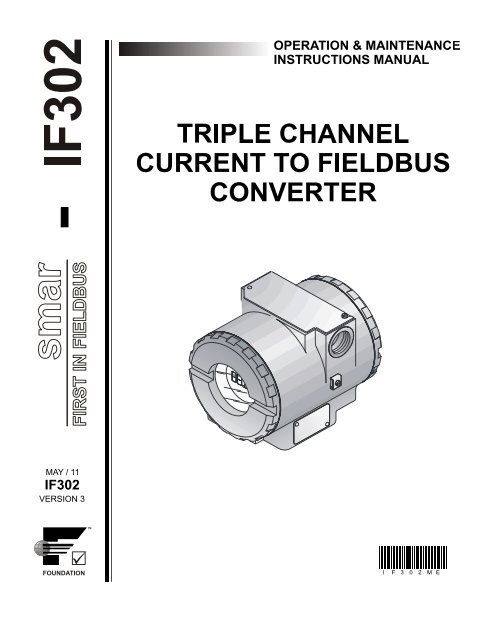
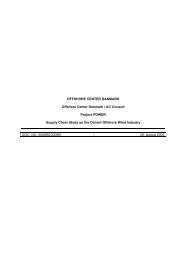
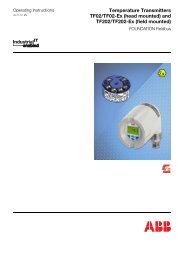
![[MI 019-120] I/A Series Mass Flowtubes Models CFS20 ... - Invensys](https://img.yumpu.com/48832334/1/190x245/mi-019-120-i-a-series-mass-flowtubes-models-cfs20-invensys.jpg?quality=85)
